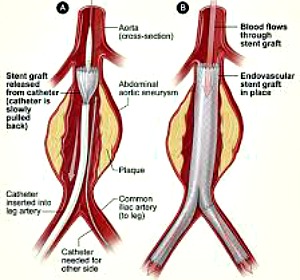Abdominal Aortic Aneurysm Repair
Things You Should Know
 Men over the age of 60 are at greater risk of developing an abdominal aortic aneurysm.
Men over the age of 60 are at greater risk of developing an abdominal aortic aneurysm.What is an Abdominal Aortic Aneurysm?
An abdominal aortic aneurysm is the enlargement, or swelling, of the aorta, the main blood vessel running from the heart that delivers blood to the abdomen, pelvis, and legs.
When the aorta widens as it runs through the
abdomen, the condition can become life threatening if left untreated. An Abdominal
aortic aneurysm is a serious medical condition that affects 5 to 7% of
people over the age of 60. Men are four times more likely to develop this
disease than women. About 15,000 people die of the disease annually, as
ruptured aneurysms that happen outside the hospital are fatal 90% of the time. The good news is that with
adequate planning, most aneurysms can be surgically repaired with great success.
Should You Repair an Abdominal Aortic Aneurysm?
Before diving into the specifics of whether to repair and abnormal aortic aneurysm, first determine what is normal, what is abnormal, and when this disease can be life-threatening.
A normal-sized aorta has a diameter of anywhere from 1.5cm to 2.5cm. When any part of the aorta widens more than 2.5cm due to swelling, inflammation, or dilation, it is usually diagnosed as an aneurysm. A small aortic aneurysm has diameter of 3 - 5.4 cm, and does not typically require surgical repair. Abdominal aortic aneurysms grow slowly (usually only 2mm to 3mm per year), so small aneurysms do not require immediate repair. Small abdominal aortic aneurysms can be treated with the use of Statins to slow the rate of expansion for most patients.
Large abdominal aortic aneurysms (those with a diameter of 5.5cm or more) do require repair. The larger an aneurysm gets, the more likely it is to rupture, and the mortality rate of abdominal aortic aneurysms increases significantly with each additional centimeter an aneurysm grows.
The decision to operate on an abdominal aortic aneurysm is usually taken if:
There is the threat of rupture, or the aneurysm
actually does rupture

When Not to Operate
Even with the presence of a large aneurysm, some patients choose not to have an operation, usually because they are physically not suitable for a surgical procedure. The decision not to operate might be appropriate if:
Where death is almost certainly imminent and an
urgent surgical repair is likely to confer no additional benefit in the opinion
of the attending surgeons
Repair Options: Open Abdominal or Endovascular?
Currently, there are two surgical options for repairing an abdominal aortic aneurysm, whether ruptured or intact.
Open Abdominal Repair
The typical procedure for an open abdominal aortic aneurysm repair involves the following:
The surgery takes less than an hour from the first cut to the last stitch.
After the open abdominal aortic aneurysm repair surgery, the patient is wheeled out of the theatre into the recovery room, and sleeps until he wakes up on his own. Upon waking, the patient may experience mild to moderate discomfort around the incision site. The attending anesthetist or nurse can get additional pain killers at patient’s request.
Abdominal aortic aneurysm repair surgery
recovery time for an open abdominal repair is 6 to 10 weeks, the first 7 to 10 days
of which patients spend in the hospital.
Endovascular Repair
Endovascular repair (EVAR) is a minimally invasive surgery to repair AAA. EVAR does not require an intensive surgical procedure, or opening the abdomen. EVAR is increasingly used as the treatment for:
EVAR offers a huge advantage over open repair because it is less invasive and a safe procedure surgeons can use to help a greater number of people. About 5% of patients discharged after a successful open abdominal repair die within the first 30 days with an open repair, while 1% of EVAR patients die within the first 30 days after surgery.
Endovascular abdominal aortic aneurysm repair involves the use of a small device to pass a graft into the ballooned part of the aorta through a pinhead-sized cut in the groin. The graft is passed through the arteries in the upper thigh or groin and allowed to “prop up” and strengthen the weak wall of the ballooned aorta segment.
Abdominal Aortic Aneurysm Repair: Tell Us Your Story!
Have you or your loved one had an abdominal aortic aneurysm repaired? Or is one being planned and you have some queries? Whatever brought you here, we would love to hear from you. Tell us your story. Share your thoughts or questions here!
|
Help Keep This Site Going |

Related Pages
You can read more about abdominal aortic aneurysm by going to any of the following pages:
|
|
Return To Abdominal Aortic Aneurysm Page From Abdominal Aortic Aneurysm Repair Page


